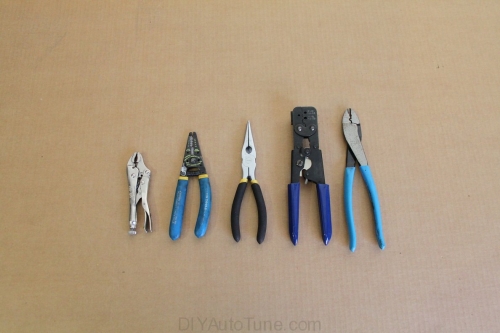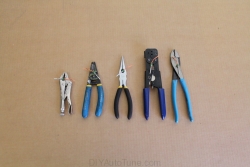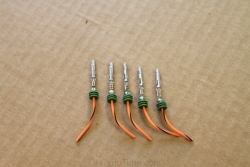How do I properly crimp and assemble my Weather Pack Connectors?
Posted on 25. Mar, 2010 by admin in Tech Articles
Check out the attached photo gallery for a detailed look at how to properly crimp and assembly Delphi Weather Pack (aka weatherpack) connectors. Click on the first image below to begin, and then just click the arrows (right) to continue through the gallery. Each image has accompanying text at the bottom describing each step in detail.
If you’d like to check out our Weatherpack Connector Kit offerings, click here.
Are all WeatherPack crimping tools created equal?
Posted on 24. Mar, 2010 by admin in Tech Articles
No they are definitely not. We tried and tried to find a super-cheap crimper (sub-$40) that would do the job right, with our hope being that we could offer a crimper for less than $30-40 that might be a little less convenient to use, but would crimp properly. We purchased and tested several models, including a couple that promised ‘a perfect crimp every time’, and in at least one case the die wasn’t even shaped right to crimp Weather Pack terminals properly, though that was the sole purpose of the crimper supposedly. In the end, we decided the cheap crimper that worked properly just didn’t exist. You can likely get by with one of these in some cases, but it WILL effect the quality of your crimps. So instead of offering my customers a tool I would never use myself, we found an extremely high quality tool that makes it easy, and we priced it just a tiny bit above our cost. We don’t make much on these, but you get a tool that helps you do the job right, and that’s important to us.
Here’s what you’re looking for in a good Weather Pack crimping tool:
1) Proper shape of the crimping dies.
The die that crimps the conductor should be ‘w’ or ‘m’ shaped (depending on how you’re holding the tool)
The die that crimps the seal over the wire insulator should be rounded.
2) Crimps both the conductor and the seal at same time
There are two separate crimps to make, one for the wire conductor, and another to hold the seal in place. A good tool will complete both of these operations in one motion.
3) Has a proper Terminal Positioning Block to ensure you crimp the terminal just right
Without the Terminal Positioning Block you’ll likely wish you had a third hand to try and hold the terminal in the proper position while also holding the seal in place and operate the tool at the same time. With this piece your crimps will be MUCH easier and you’ll have a much higher success rate.
4) Racheting mechanism to ensure proper crimp pressure
This will ensure that you’ve crimped hard enough, but not too hard, getting the crimp pressure on the terminal just right.
We’re happy to offer a tool that meets all of the above requirements, and truly gives you an honest shot at getting ‘a perfect crimp every time’. Others promise this, but this tool can deliver it.
You can click here to check out and/or purchase the high quality crimping tool we recommend.
The Proper Tool for the Job
Posted on 22. Mar, 2010 by weatherpacknumber1 in Tech Articles
Often you can get away with a tool for a job it wasn’t intended for, producing a similar result as if the proper tool was used in the first place. A screwdriver can be used instead of a seal puller for axle seals or a rear main, wrenches can be doubled up instead of a breaker bar for a tough fastener. It can be difficult to achieve a strong, reliable crimp on a Weather Pack terminal without the use of a proper crimping tool.
We will try to make some crimps with various tools around the shop here and compare them to the crimp from a proper ratcheting Weather Pack crimper. I followed the same general method with all tools except the Weather Pack crimpers.
Lets start off with some small Vice-Grips.
The Vice-Grips as used in the images above were a bit difficult to use. I found them best when adjusted so I could find a good balance point right before they locked down. I found myself going back and forth between multiple angles trying to make each of the four crimps just right. I would say I needed to tweak each of the four areas (two seal tabs and two wire crimps) at least five or six times each!!
Next up I tried a set of high-end crimping pliers.
These crimping pliers used above weren’t all that bad to use due to the various shaped areas available to squash the terminal inside of. The same remains, I again needed to bend and tweaked each of the four areas at least fire or six times each.
Third I tried a pair of wire strippers. This may not be what most people reach for to crimp terminals, but these aren’t normal crimp terminals either.
This process was nearly identical to the Vice-Grips as I was only really able to use the end nose of this tool to shape the terminal.
Needle nose pliers are up next.
Not much difference to report here with the needle nose as seen above. Since they had a smaller nose tip they were able to shape the seal tabs a bit better than other tools, yet I still needed to hit each of the four crimp areas multiple times to achieve a finished product.
Finally come the ratcheting Weather Pack crimpers.
This was a night and day difference to every tool I tried. Insert the terminal into the pliers, lay your wire and seal combo in the appropriate location, crimp, done!
In the terminal comparison picture above, the Weather Pack crimp is on the left with the wire bent opposite all the others.
I was surprised I didn’t butcher the terminals more than I did when not using the ratcheting Weather Pack crimper. I did, however, take my time on each one (several minutes per terminal) to do the best I could with each tool. Once you have a good rhythm down, a good crimp with the ratcheting Weather Pack crimpers can take as little as 20 seconds. Add up all the terminals you’d be crimping if you’re building out a complete harness. The time wasted when not using the correct tool for the job would be huge!!










































































